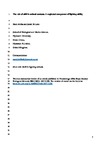The role of skill in animal contests: a neglected component of fighting ability
| dc.contributor.author | Briffa, Mark | |
| dc.contributor.author | Lane, Sarah | |
| dc.date.accessioned | 2017-11-14T09:38:57Z | |
| dc.date.available | 2017-11-14T09:38:57Z | |
| dc.date.issued | 2017-09-27 | |
| dc.identifier.issn | 0962-8452 | |
| dc.identifier.issn | 1471-2954 | |
| dc.identifier.other | ARTN 20171596 | |
| dc.identifier.uri | http://hdl.handle.net/10026.1/10155 | |
| dc.description.abstract |
<jats:p>What attributes make some individuals more likely to win a fight than others? A range of morphological and physiological traits have been studied intensely but far less focus has been placed on the actual agonistic behaviours used. Current studies of agonistic behaviour focus on contest duration and the vigour of fighting. It also seems obvious that individuals that fight more skilfully should have a greater chance of winning a fight. Here, we discuss the meaning of skill in animal fights. As the activities of each opponent can be disrupted by the behaviour of their rival, we differentiate among ability, technique and skill itself. In addition to efficient, accurate and sometimes precise movement, skilful fighting also requires rapid decision-making, so that appropriate tactics and strategies are selected. We consider how these different components of skill could be acquired, through genes, experiences of play-fighting and of real fights. Skilful fighting can enhance resource holding potential (RHP) by allowing for sustained vigour, by inflicting greater costs on opponents and by minimizing the chance of damage. Therefore, we argue that skill is a neglected but important component of RHP that could be readily studied to provide new insights into the evolution of agonistic behaviour.</jats:p> | |
| dc.format.extent | 20171596-20171596 | |
| dc.format.medium | ||
| dc.language | en | |
| dc.language.iso | en | |
| dc.publisher | Royal Society, The | |
| dc.subject | contest | |
| dc.subject | fight | |
| dc.subject | skill | |
| dc.subject | vigour | |
| dc.subject | resource holding potential | |
| dc.subject | agonistic behaviour | |
| dc.title | The role of skill in animal contests: a neglected component of fighting ability | |
| dc.type | journal-article | |
| dc.type | Journal Article | |
| dc.type | Review | |
| plymouth.author-url | http://gateway.webofknowledge.com/gateway/Gateway.cgi?GWVersion=2&SrcApp=PARTNER_APP&SrcAuth=LinksAMR&KeyUT=WOS:000411723200003&DestLinkType=FullRecord&DestApp=ALL_WOS&UsrCustomerID=11bb513d99f797142bcfeffcc58ea008 | |
| plymouth.issue | 1863 | |
| plymouth.volume | 284 | |
| plymouth.publication-status | Published | |
| plymouth.journal | Proceedings of the Royal Society B: Biological Sciences | |
| dc.identifier.doi | 10.1098/rspb.2017.1596 | |
| plymouth.organisational-group | /Plymouth | |
| plymouth.organisational-group | /Plymouth/Faculty of Science and Engineering | |
| plymouth.organisational-group | /Plymouth/Faculty of Science and Engineering/School of Biological and Marine Sciences | |
| plymouth.organisational-group | /Plymouth/REF 2021 Researchers by UoA | |
| plymouth.organisational-group | /Plymouth/REF 2021 Researchers by UoA/UoA04 Psychology, Psychiatry and Neuroscience | |
| plymouth.organisational-group | /Plymouth/Research Groups | |
| plymouth.organisational-group | /Plymouth/Research Groups/Marine Institute | |
| plymouth.organisational-group | /Plymouth/Users by role | |
| plymouth.organisational-group | /Plymouth/Users by role/Academics | |
| plymouth.organisational-group | /Plymouth/Users by role/Researchers in ResearchFish submission | |
| dc.publisher.place | England | |
| dcterms.dateAccepted | 2017-08-25 | |
| dc.identifier.eissn | 1471-2954 | |
| dc.rights.embargoperiod | Not known | |
| rioxxterms.versionofrecord | 10.1098/rspb.2017.1596 | |
| rioxxterms.licenseref.uri | http://www.rioxx.net/licenses/all-rights-reserved | |
| rioxxterms.licenseref.startdate | 2017-09-27 | |
| rioxxterms.type | Journal Article/Review | |
| plymouth.funder | The role of additive and non-additive genetic effects during animal contests in the beadlet sea anemone Actinia equina::BBSRC |


